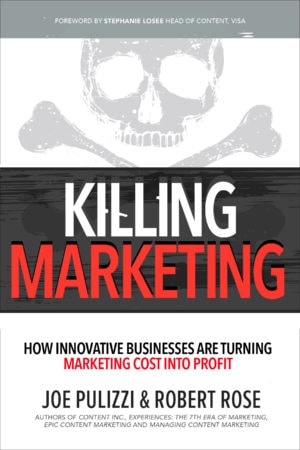
Book Preview: Killing Marketing by Joe Pulizzi & Robert Rose
What if everything we ‘know’ about marketing is wrong?
Joe Pulizzi and Robert Rose raise fundamental questions about marketing in their new book, Killing Marketing, which will come out in September. Marketing leaders will find big new ideas to consider in this powerful work of thought leadership.
The book helps marketers address questions such as:
What if what we’ve been taught or experienced in marketing doesn’t show us the full picture?
What if we’ve limited our view of marketing to one area (what we know), and that is not allowing us to see the full potential of what can be accomplished (what we do not know yet)?
What if placing marketing solely in the marketing department is killing the approach of marketing as a strategic business process?

Pulizzi and Rose point to signs that marketing is slowly killing itself.
How so?
- Making incremental changes at a time that demands disruption, when marketing needs to transform itself into a business’ strategic growth driver.
- Interrupting customers with advertising that causes friction instead of giving buyers what they need to succeed: friction-free answers, insights, entertainment and community.
- Separating marketing into media channel siloes that must compete for budget, support and attention, rather than focusing on the big job of capturing an audience and creating targeted content that’s so good it can be sold at a profit.
As Pulizzi and Rose observe, today marketers use content in 3 basic ways, to:
- Increase revenue (Sales goal or winning customers)
- Save costs (Savings goal or creating customers at a lower cost)
- Create more loyal customers (Retention goal or keeping customers).
Now companies can transform marketing from a cost into a profit center.

Companies can make money with content by becoming publishers who take a professional approach. Companies like Red Bull, Lego, and Arrow Electronics are already generating profits from content business units. They’re lighting a path that shows how to generate profits with powerful content that attracts new followers and subscribers.
Pulizzi and Rose cite what Peter Drucker said 60 years ago: the purpose of business is “to create and keep a customer.” As Drucker also said, “Marketing and innovation produce results; all the rest are costs. Marketing is the distinguishing, unique function of the business.”
The book proposes radical cures for what ails marketing:
Go way beyond describing value: create value with content.
What if your content not only educated buyers, but also generated a profit?
Companies are doing exactly that today as they:
- Build audiences of buyers or acquire media properties that already have an established audience.
- Listen to gain unique insights from buyers’ pain points.
- Offer buyers content, media, and events that address specific interests.
- Create products and services that their audience wants from them.
As companies deliver great content, they become an audience’s go-to source of information as they:
- Stage events that deliver a great experience as you bring buyers face to face.
- Build a strong community around the topics the audience is interested in.
- Make content so good that buyers willingly pay for it, as Lifetime Fitness did with its magazine and the Content Marketing Institute with its conference.
Put the audience first.
Get to know your buyer persona better than anyone else. Publish content regularly to attract subscribers who fit the buyer persona. Listen to learn their needs, then deliver valuable content and experiences to them.
Gather data and seek insights into which products and services your audience wants from you. With the right audience, you can even help R&D spawn ideas for new products and services.
Address each audience with content about the topics it wants to know. It’s all about what buyers want to consume, not what Sales want to produce. Keep the focus on buyers, their needs, their pain points, and their solutions.
Break down artificial boundaries between content and marketing.
While most marketers publish content today, most don’t approach content as a separate business. When approached as a separate, profit-making business, content can realize its full potential to win attention, subscribers, buyers, customers, sales, and revenue.
Many companies take the easy way out – by publishing content that’s safe. They say the same things that everyone else in their industry says, rather than risking a unique opinion or viewpoint. But you can’t “out-obedience” your competitors, as Seth Godin said.
Acquire, curate, or create content that audiences find valuable.
For example, Arrow Electronics bought a number of trade magazines and websites in the electronics space to make itself the content leader for electrical engineers.
Content is a separate Arrow profit center that enables the company to reach its buyers at a lower cost than before. “Not only has Arrow purchased amazingly valuable subscriber lists and editorial talent, but it also purchased stand-alone marketing that is profitable unto itself,” Rose writes.
“Over the last two years, Arrow Electronics has established itself as the largest media company in electronics. In February 2015, Arrow purchased 16 engineering websites, e-newsletters, inventory access tools, and databases from Hearst’s United Technical Publications. One year later, the company acquired the entire electronics media portfolio of UBM, including the brands EE Times, EDN, SEM, Embedded, EBN, TechOnline, and DataSheets.com for $23.5 million.”
Content operates as a separate profit center in companies such as Johnson & Johnson:
Johnson & Johnson operates BabyCenter.com as a completely separate division of the company. BabyCenter reaches more than 45 million parents a month from every corner of the globe through its 11 owned and operated properties in nine different languages. Eight of every 10 U.S. mothers use BabyCenter.”
Measure what matters: audience, sales, and revenue.
Generate the minimum amount of content that can achieve maximum results, Rose says.
Don’t make a false assumption such as the more times a customer touches your content, the likelier they are to buy. Instead, build a friction-free flow of content to turn readers into subscribers, and subscribers into customers over time.
More and more companies will succeed in marketing by not only describing value but also by creating value with profitable content. That’s a lesson demonstrated by the Michelin Guide more than a century ago.
Killing Marketing shows how companies can learn to transform content marketing from a cost center to a profit center. In so doing, the book defines a new future full of potential for content and marketing.
I look forward to getting my hands on a copy of the book soon, at Content Marketing World in Cleveland. I hope to see you there!
Enough said.





